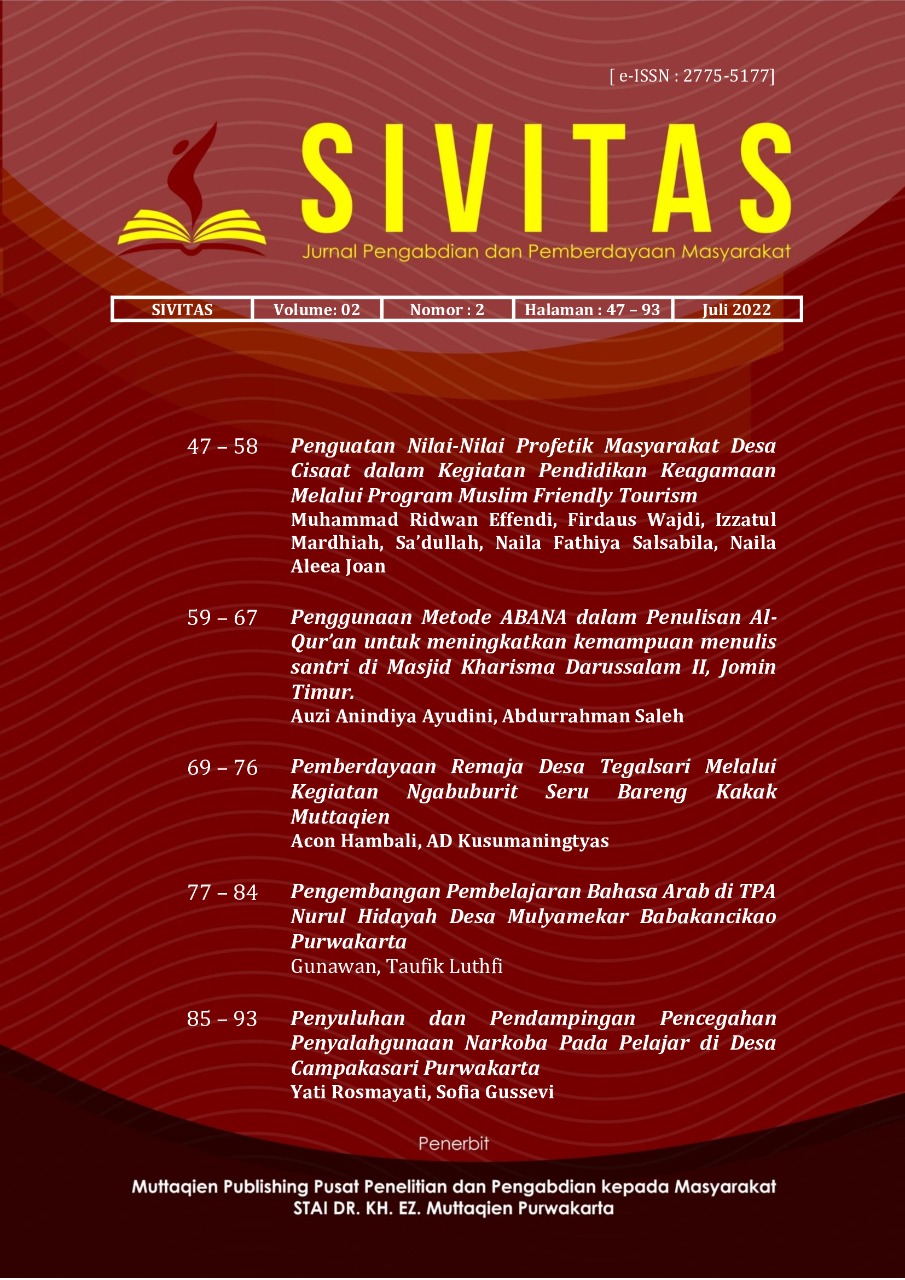Pengembangan Pembelajaran Bahasa Arab di TPA Nurul Hidayah Desa Mulyamekar Babakancikao Purwakarta
Pengembangan Pembelajaran Bahasa Arab
Abstract
This Dedication about "Development of Arabic Learning at TPA Nurul Hidayah" is motivated by the importance of learning Arabic from an early age as well as the understanding that must be obtained by students, Arabic learning must be carried out in a way that is varied but also effective so that Arabic learning can be achieved. easily digested and accepted by students, one of them is by using the ghina method or singing. The singing method is a learning method that uses sung poems. Usually these poems are adapted to the materials that will be taught by educators. According to some experts, singing makes the learning atmosphere cheerful and passionate so that children's development can be stimulated more optimally. With these benefits, the devotees improvise the singing method for the improvement and development of Arabic learning. This research and service uses a qualitative-descriptive method with a process of observation, implementation (learning) and evaluation. and the result is a fairly large increase in the development of understanding and memorization of students, hopefully the results of this service will provide many benefits for the development of Arabic, especially in TPA Nurul Hidayah.
References
Acep Hermawan, Metodologi Pembelajaran Bahasa Arab, (Bandung: PT. Remaja Rosdakarya, 2011), 32
Undang-undang No. 20 Tahun 2003 tentang Sistem Pendidikan Nasional.
Dr. Dedih Wahyudin, M.Ag. (2020). Metodologi Pembelajaran Bahasa Arab. Bandung : PT Remaja Rosdakarya.
Abdul Wahab Rosyidi, M.Pd. (2009). Media Pembelajaran Bahasa Arab. Malang : UIN-Malang Press.
Dr. Izzudin Musthafa, M.A. Dr. Acep Hermawan, M.Ag. (2018). Metodologi Penelitian Bahasa Arab konsep dasar, startegi, metode, teknik. Bandung : PT Remaja Rosdakarya.
Jamal Ma’mur Asmani, Manajemen Strategi Pendidikan Anak Usia Dini (PAUD), (Yogyakarta: Diva press, 2009), h. 5.
http://etheses.uin-malang.ac.id/588/5/10410136%20Bab%202.pdf
Published
How to Cite
Issue
Section
SIVITAS: Jurnal Pengabdian dan Pemberdayaan Masyarakat allow the author(s) to hold the copyright without restrictions and allow the author(s) to retain publishing rights without restrictions and authors who publish with this journal agree to the following terms:
In developing strategy and setting priorities, SIVITAS: Jurnal Pengabdian dan Pemberdayaan Masyarakat recognize that free access is better than priced access, libre access is better than free access, and libre under CC-BY-SA or the equivalent is better than libre under more restrictive open licenses. We should achieve what we can when we can. We should not delay achieving free in order to achieve libre, and we should not stop with free when we can achieve libre.
SIVITAS: Jurnal Pengabdian dan Pemberdayaan Masyarakat has a CC-BY SA license or its equivalent as the optimal license for publication, distribution, use and reuse of scientific work. This license is under a Creative Commons Attribution 4.0 International License.
You are free to:
- Share — copy and redistribute the material in any medium or format
- Adapt — remix, transform, and build upon the material for any purpose, even commercially.
- The licensor cannot revoke these freedoms as long as you follow the license terms.










